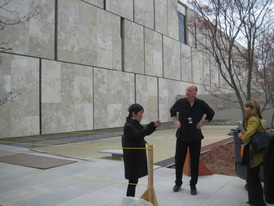
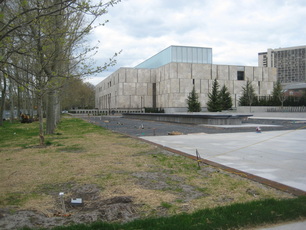
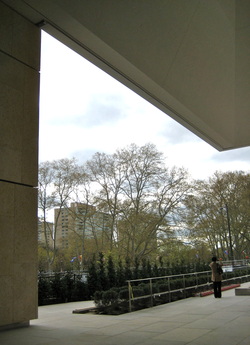
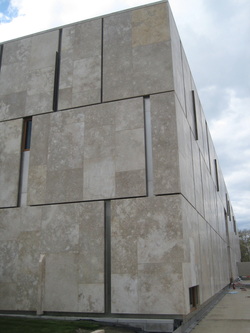
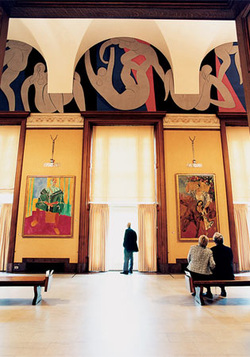
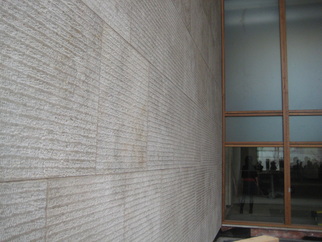
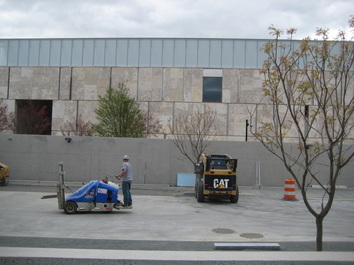
All building photos by Marilyn MacGregor (no inside photos were allowed)
http://www.barnesfoundation.org/
| artsmarttalk.com |
|
 Billie Tsien and Tod Williams The new Barnes Foundation on the Ben Franklin Parkway in the center of Philadelphia will be open in just a few weeks - May 19 is the kickoff date for members. After all the controversy and (much ridiculous) ranting and raving, the storied collection is being hung, and workers are scrambling to finish up construction and landscaping. I had the good fortune to be on a tour last week with Tod Williams and Billie Tsien, the architects for the building, so here's a first-hand preview.  from the Parkway side The new building is miles away, figuratively as well as literally, from the 1922 Beaux Arts building designed by Paul Cret in Lower Merion. This isn't bad - it's good. The old building is beautiful, but served a different time and audience. The new building is clean, elegant, spacious, and full of light, with spaces tailored for use by a broader public than ever saw the Barnes Collection in its original home, including an auditorium, classroom, library and a lounge with a café. A gallery for temporary exhibits and a well-appointed, up-to-date conservation studio expand the purposes and possibilities. The dramatic center of the new building is a light-filled hall that divides and connects, with the entrance areas and new gallery on one side and the revered collection, intact and carefully preserved in galleries that precisely reproduce the old experience in letter and spirit, on the other.  The terrace with cantilevered overhang This high, wide central atrium space leads onto a terrace under a cantilevered overhang, meeting the garden setting for the building and allowing for a pleasantly veiled view of the busy city beyond the trees. ‘A Gallery in a Garden’ was the architect's mantra, one they fulfilled in large and small ways on all sides of the building. One garden is even inside, opening to the sky to bring in light and air to lower level spaces where people will congregate. Along the Parkway a long section with a rectangular fountain will be an open public garden.  The facade mosaic The building is faced with smooth limestone slabs of varying size, fitted into a mosaic spaced with slits and windows. Crowning the roof is a frosted glass clerestory that softens the geometric shape against the sky and brings an abundance of filtered light into the interior spaces. The exterior stone, a soft golden color and almost soft to the touch, is also inside - in places chipped by hand in a regular/irregular pattern the architects call ‘cuneiform,’ and in others given a different texture that quietly bounces the natural light. The architects' attention to materials that have meaning as well as aesthetic appeal is also evident in the wooden floor of the central hall. Laid in a herringbone pattern of varying tones, the boards are recycled from the old Coney Island Boardwalk in New York!  Inside the old Barnes (soon to be inside the new) Huge wood framed windows with mullions looking into the galleries from the hall are a reminiscent feature that visitors to the old Barnes will recognize; here though, for the most part, the windows won't be shaded. We weren't allowed into the galleries on our tour, but we could glimpse a few frames and ... yes, Barnes’s beloved gadgets on the... yes, burlap covered (or what looks like it) - walls. Apparently there are a few changes that will enhance the galleries such as higher ceilings, but nothing noticeable - we were assured that the maximum difference in the hanging of any of the works would be 1/8 inch.  The 'cuneiform' pattern on the stone The building systems, unseen but essential, are a testament to modern technology; the Barnes has been awarded a LEED Platinum certification for energy efficiency, the highest rating possible and a rare achievement. The collection will benefit in a number of ways, including a shade system to precisely regulate light to ensure the best levels for the paintings at any given time.  almost there Standing back from the building I once again had a chance to consider how thoughtfully and well the design balances respect with innovation, inside and out. (I had had the same thought on seeing the plan presented in 2009 at a public meeting.) The façade with its irregular mosaic pattern could be a metaphor for Barnes’ own eclectic philosophy. A careful, logical plan with beautiful materials, both mellowed and energized by irregularly sized openings - personal preferences, artistic choices, various cultural traditions, a mix of unexpected elements. All building photos by Marilyn MacGregor (no inside photos were allowed) http://www.barnesfoundation.org/
7 Comments
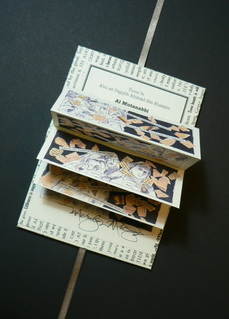 'The Best Companions are Books Alone' open I usually write about other people's art on this blog, but this time I want to share a project I've been working on. It's a book - handmade, hand-bound, with prints of original drawings - and I'm doing it as part of a world-wide movement called the Al-Mutanabbi Street Coalition. The background: There was once a great Arabic writer named Abu at-Tayyib Ahmad ibn Huseyn. Born in the 10th century, he was the son of a water carrier, a born revolutionary, and a court poet for an Arab Prince. His nickname, Al-Mutanabbi, means 'the would-be prophet.' He was eventually killed, perhaps because, in a poem, he insulted a powerful man. For centuries the Baghdad street named after him was the center of intellectual life, with books and booksellers everywhere, and cafes buzzing with lively literate discussions. 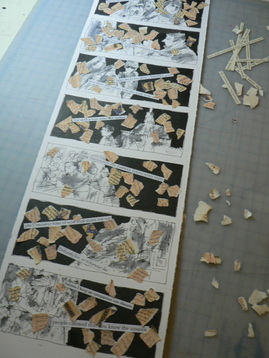 in progess. Collaging shreds to the drawings But then came March 5, 2007, and life on Al-Mutanabbi Street was blown to bits by a car bomb. More than 30 people were killed, more than 100 wounded - and the heart of literate Iraq was dealt a death blow. Or at least that was the intent. Kill ideas, kill thought, kill expression - it's a rusty old weapon in the violent arsenal of control and oppression. Al Mutanabbi Street reopened for business in 2008, but no one can think it will easily return to normal. For several years, The Al-Mutanabbi Street Coalition has been working to counter the destruction of books, ideas, intellectual pursuits, literary accomplishment, and the dignity of the Iraqi people. The organizers, Beau Beausoleil and Sarah Bodman, have been gathering letterpress printed broadsides and artist books, giving talks, presenting exhibits, and in many other small and large ways, keeping the spirit of Al-Mutanabbi Street alive. 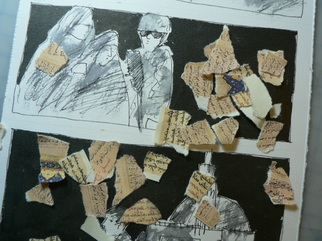 drawing for 'The Best Companions are Books Alone' in progress I'm told that some early submission were focused on war. I hope mine won't be seen as war-focused, though it is impossible not to have that idea hovering nearby. I purposely chose images from daily life, including a sketch of Al-Mutanabbi Street before the blast, along with a mosque, women on the street, men in a cafe - and an American soldier, because that has also been, for too long, part of daily life there. I could not get the image of all that tragic but beautiful Arabic confetti showering down after the bomb went off out of my mind, so I've made that important. 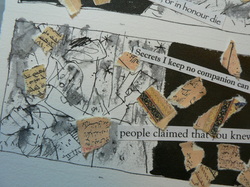 Drawing of the Abbasid Court where Al-Mutanabbi worked and lived in the 10th c. The cover text and text across the images are English translations (by Nancy Coffin) of Al-Mutanabbi poems - beautiful language but much of it chillingly prescient about harm and violence. (The title, ‘The Best Companions are Books Alone’ is a quote.) make the I reduced the size of the images when I printed them before I folded them into the accordion - I wanted to make the book something that could be hidden in a pocket if necessary. 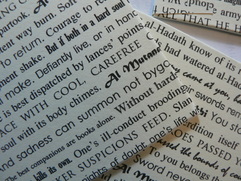 My book is one of three I'll send them - along with the others, one of mine will be donated to the Iraqi National Library in Baghdad. The other two will become part of the exhibits and displays. Read Beau Beausoleil's description of the Al-Mutanabbi Coalition project here: http://www.scribd.com/doc/36553491/An-Inventory-of-Al-Mutanabbi-Street If you'd like to see more of my hand-made artist books visit my website and on-line store - click here http://www.marilynmacgregor.com/artist-books.html all images and book ©Marilyn MacGregor 2011 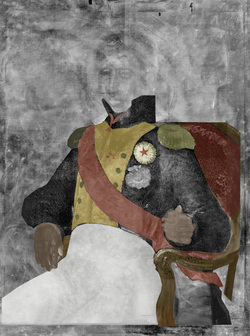 Goya has always been hard to pin down. The discovery of a 'new' portrait, albeit hidden under an existing one, just adds to the complex story of this fascinating artist. Who is among the most modern of 'old masters'? Goya. Who made his living painting fawning portraits of powerful court patrons? Goya. Who is one of the most subversive of all painters? Goya. Who was one of the first realist painters? Goya. Who painted the darkest, most terrifying images in all of art? Goya. And did I mention that he had 24 children? The new painting, an unfinished formal portrait of a man wearing the important bling of a Napoleonic officer (it may even be Joseph Bonaparte, appointed King of Spain by his brother the Emperor) was discovered with the fresh out of the box Scanning Macro X-ray Fluorescence Spectrometry, a technology developed in the Netherlands and Belgium. This is a technique that "fires high-energy x-rays at the painting, which energizes the atoms causing them to release their own x-rays. By observing and analyzing this information, researchers are able to develop a color map of what lies beneath the top layer of paint. The result shows remarkable detail about what was originally on the canvas."(thanks to Geekosystem.com) 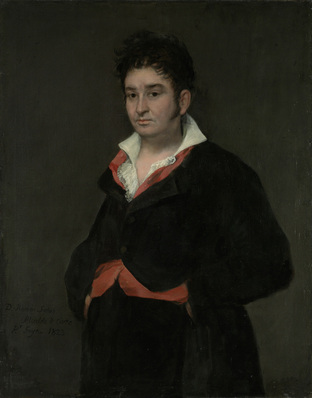 The portrait on top - the only one that counts for most of us - is one of Goya's masterpieces and the only painting by Goya in the Netherlands (at the Rijksmuseum.) It is a beauty - the subject is Judge Don Ramón Satué, a man in whose face intelligence, skepticism, compassion, and confidence all jockey for position. His hair is fashionably feathered forward, his black velvet costume, accented with white ruffles and red sash, is stylishly comfortable - no formal robes for this judge. It was painted in 1823, ten years after the French were driven out of Spain. It seems probable that Goya was commissioned to paint the underlying portrait during the French occupation; one speculation about the reuse of the canvas is that he needed to get rid of any evidence of collaboration once Ferdinand VII was restored to the Spanish throne. 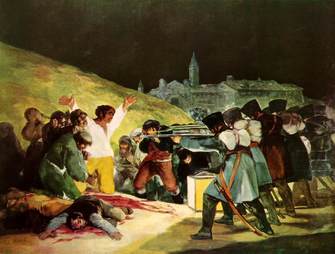 It's unlikely that Goya would have cooperated willingly with Napoleonic forces. His powerful The Third of May from 1808 is an eyewitness account of injustice; it screams out Goya's protest against the inhumanity of that occupation with his pitting of an innocent man - clearly marked as a symbol of all innocence by his bright white shirt and crucifix pose - against the faceless brutality of a uniformed firing squad. Click to set custom HTML 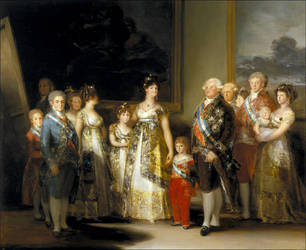 Goya lived at one of the cruelest and most crucial cusps of history, a time when old tyrannies were exploding in revolutions. Harsh, inhumane oppressions in response, did little to stem the tide of inevitable progress towards equality and democracy, but led to wide-spread misery for many innocent people. Goya witnessed all of this - in his work we find the cycle of history. The golden, sunlit days of court life edge into clear-eyed observations and documents of the wealthy and powerful, perhaps with a touch of muffled but barbed criticism, as in his celebrated portrait, The Family of Carlos IV. 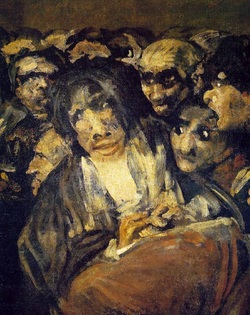 The march of his witness continues - he spares no detail about the unspeakable horrors of war with his incredible series of etchings, The Disasters of War. We then watch him descend into a personal world of darkness, losing his hearing, going into exile in Bordeaux, and creating the searing, unspeakable Black Paintings and Horrors. Click the link below for an interactive look at the new and old Goya portraits (Thanks to The Guardian UK) http://www.guardian.co.uk/artanddesign/interactive/2011/sep/20/goya-painting-satue-rijksmuseum-interactive?intcmp=239 |
Share ArtSmartTalk
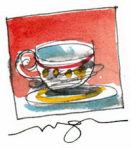
MacGregor-Art.com Cards and art gifts with a Fine Sense of Fun Also at http://www.etsy.com/shop/MacGregorArt ArtSmart Consulting
|
| Blog: |
| ArtSmartTalk |
Topics: |
| Art History, Design, Art |
All
19th C Art4a3f8ec7db
20th C59300e1f29
African Art
Almutanabbi Streetbb1c3786e2
American Art
Ann Hamilton
Apple
Apple Computers
Arabic Poetry
Architecture
Art
Art And Nature
Art And Technology
Art As Collective Memory
Art Auctions
Art Books
Art Forgery
Art Galleries
Art History
Art In Gardens
Art Installation
Art Installations
Art Licensing
Art Of Spain
Art Prints
Art Technology
Baghdad Books
Barnes Collection
Biennial
Book Project
Books
Brooklyn Museum
California Design
Chelsea Galleries
Chess
Color
Constable
Contemporary Architecture
Contemporary Art
Contemporary Design
Design
Detroit Institute Of Arts
Drawing
E H Shepard
El Anatsui
Etching
European Art
Expressionism
Fabric Design
Flags
Folk Art
French Art
French History
French Portraits
Galleries
George Bellows
Goya
Goya Black Paintings
Goya Portrait
Hand-made Books
Historical Art
Hokusai
Ho Tanner
Illustration
Installation Art
Iraq
Jean Clouet
Lacma
Lewis Chessmen
London
Los Angeles
Mac Computers
Mary Cassatt
Matisse
Met Museum
Metropolitan Museum
Metropolitan Museum Of Art
Modern Art
Modern British Painting
Moma
Moma Ps1
Moons
Museums
Napoleon
National Gallery
Nature
New Architecture
New Art
New Design
New Goya Painting
New York
New York Art
Norse Art
Novels About Art
Old City Philadelphia
Online Art Sites
Outdoor Art
Outsider Art
Painting
Paris
Pat Steir
Performance Art
Philadelphia
Philadelphia Art
Philadelphia Museum
Photography
Plein Air
Portraits
Product Design
Red
Religious Art
Rembrandt
Rome
Rothko
Royal Portraits
Sarah Sze
Scottish Art
Self-portraits
Significance Of Art
Sketching
Southern California
Soutine
Spanish Art
Spanish History
Steve Jobs
Technology
Thanksgiving
The Importance Of Art
Turner
Van Gogh
Velasquez
Venice Biennale
Whitney Museum
Words And Art
Young Artists
August 2013
May 2013
February 2013
January 2013
December 2012
November 2012
October 2012
September 2012
August 2012
July 2012
June 2012
May 2012
April 2012
March 2012
February 2012
January 2012
December 2011
November 2011
October 2011
September 2011
August 2011
July 2011